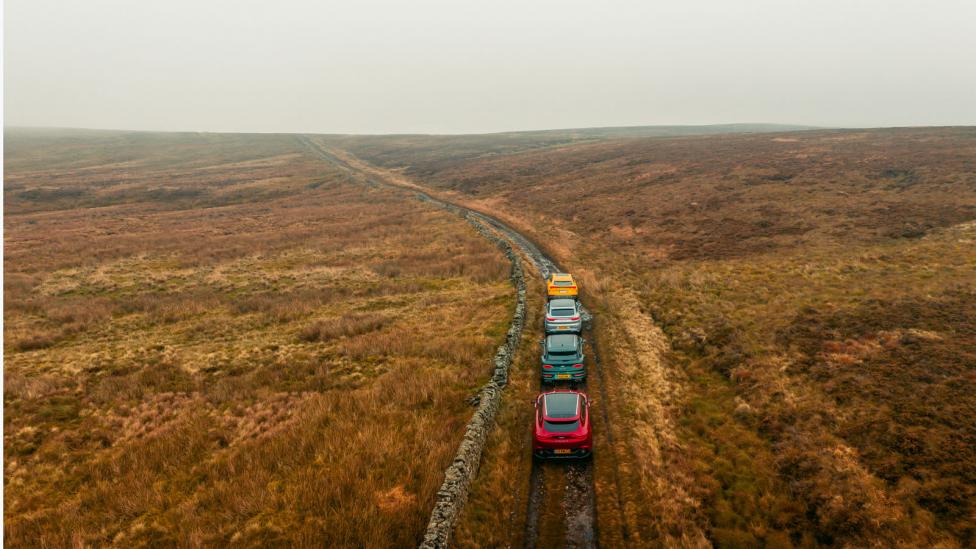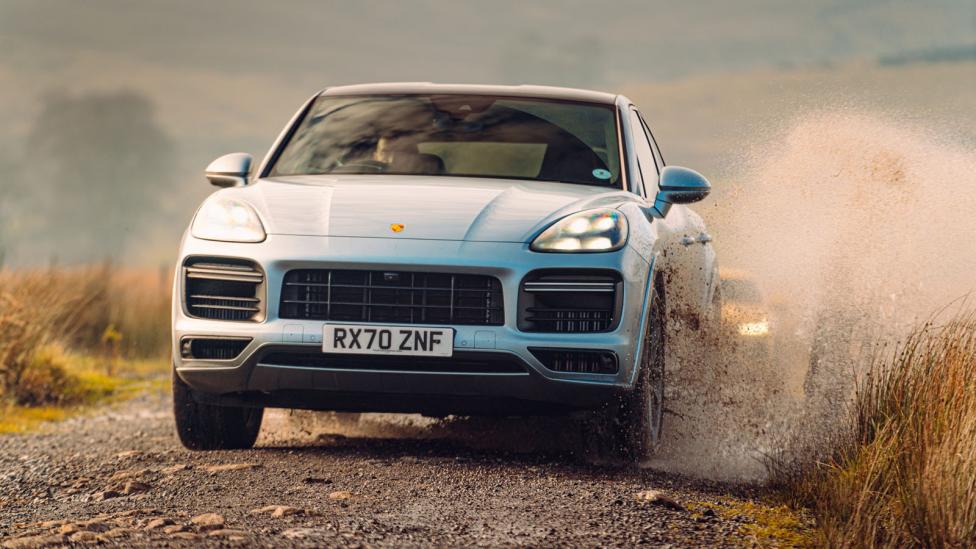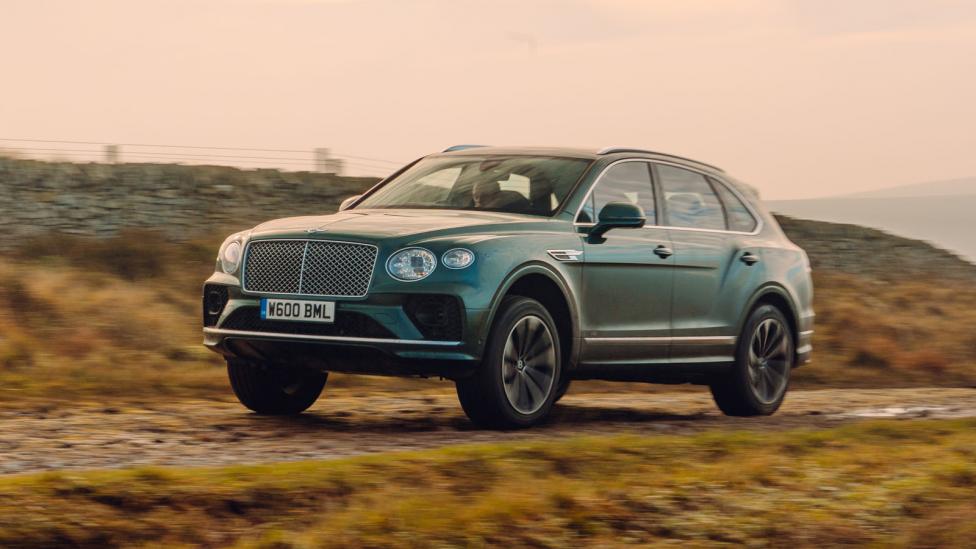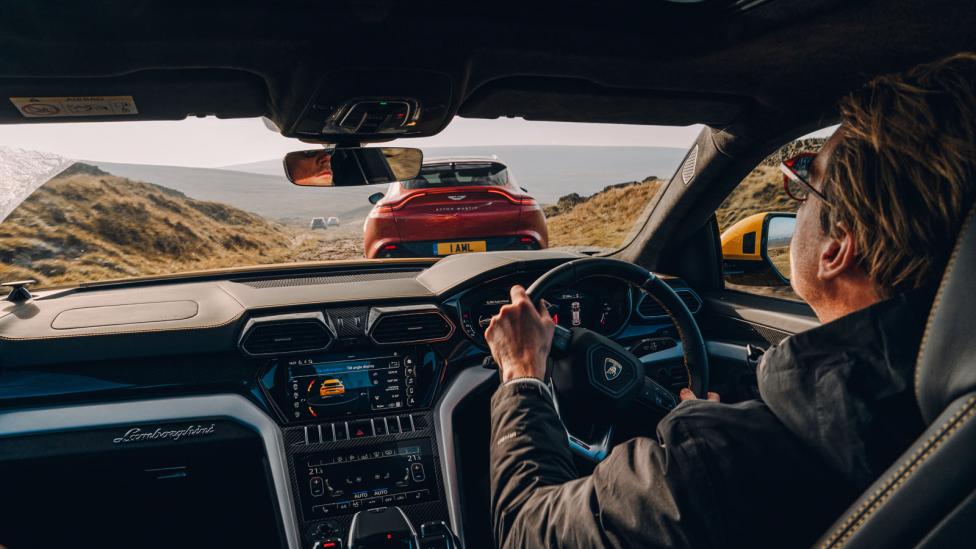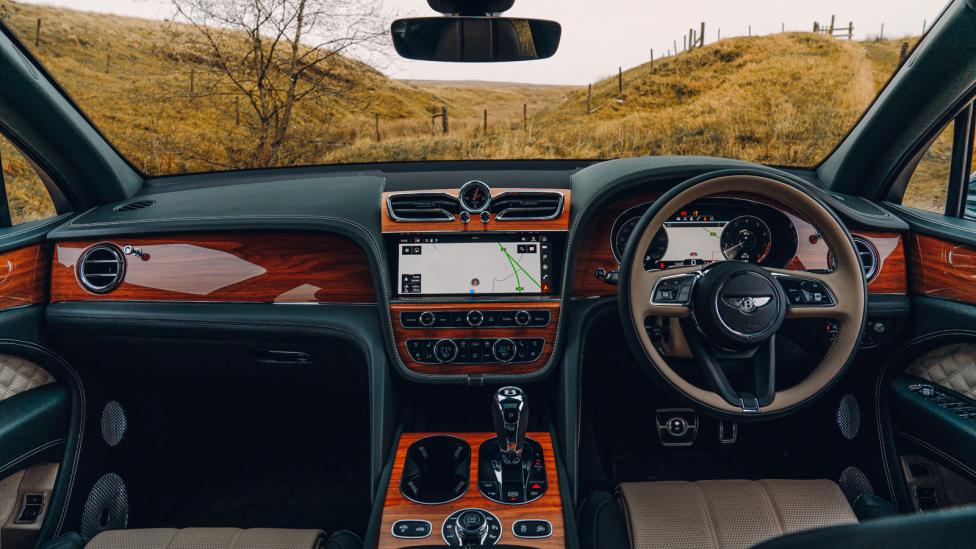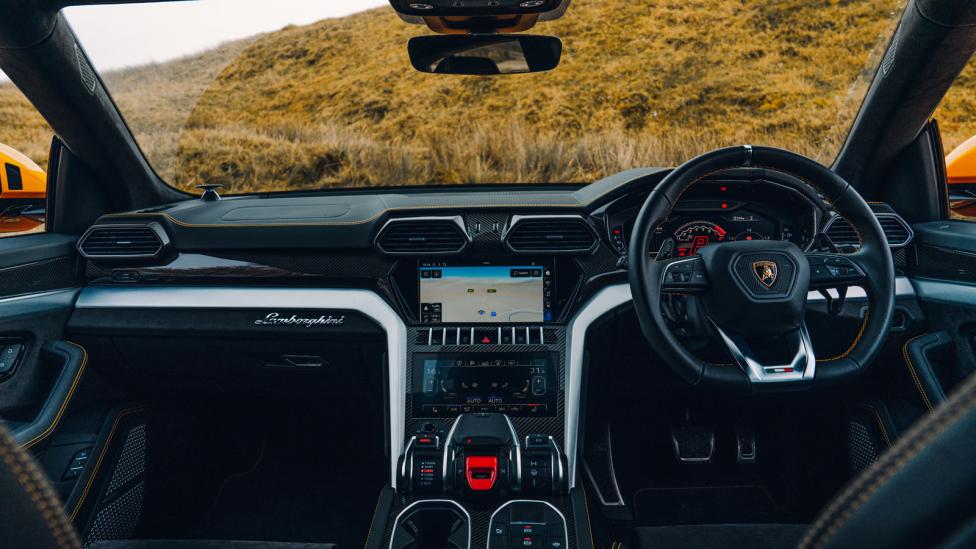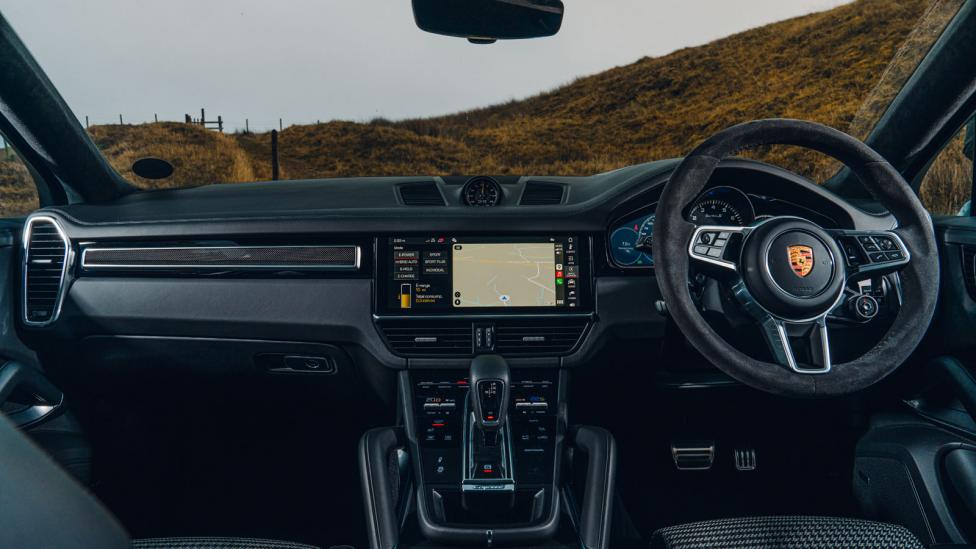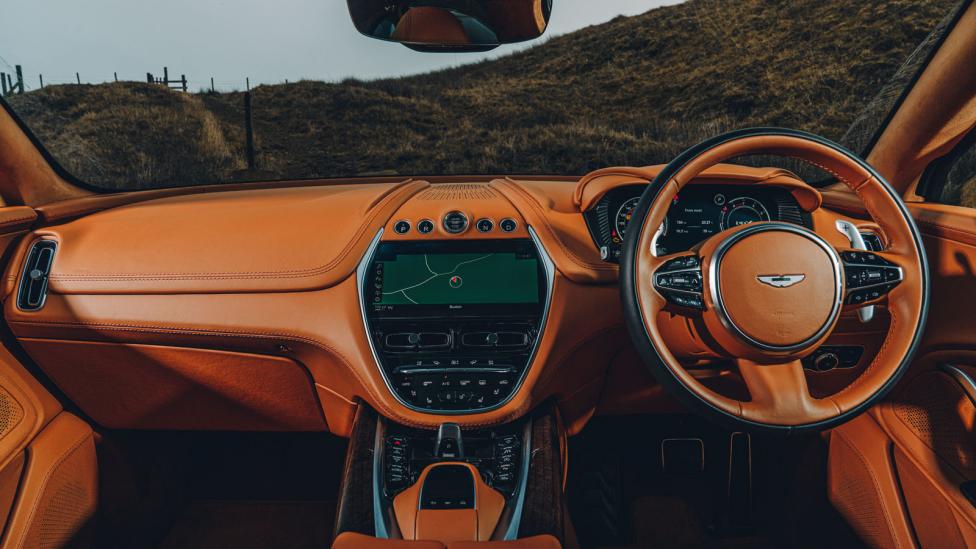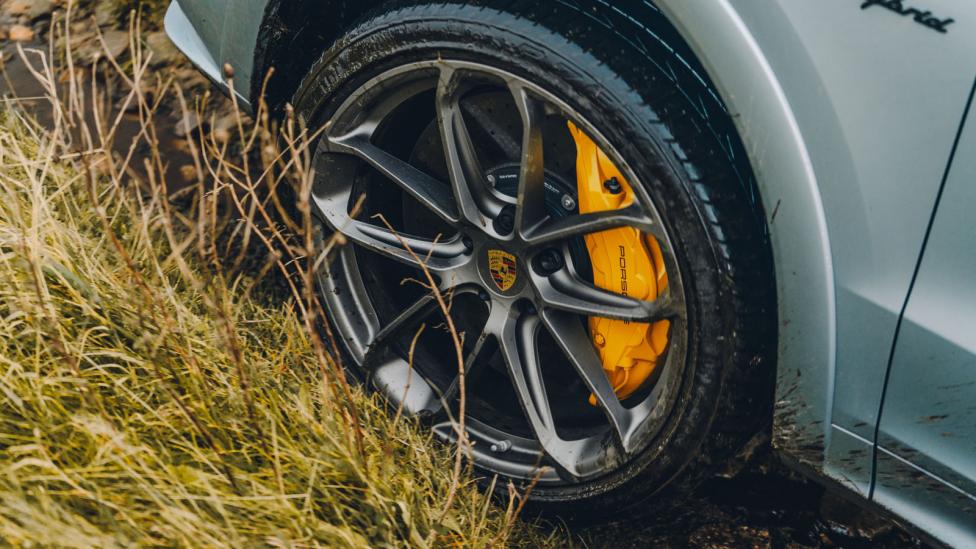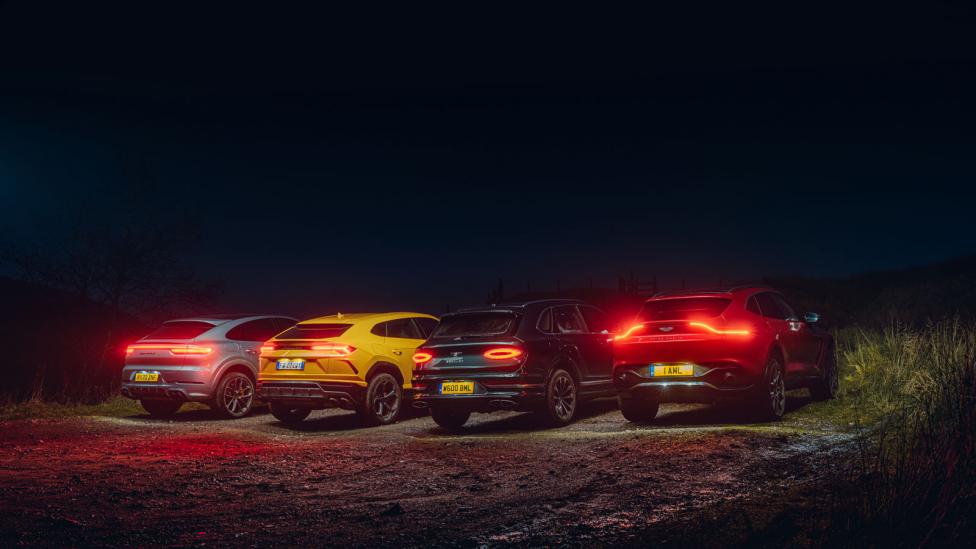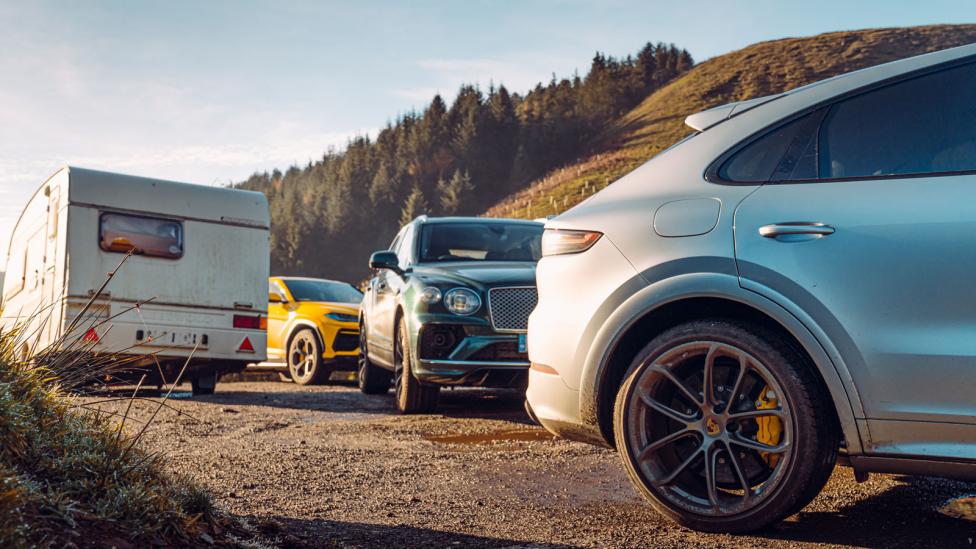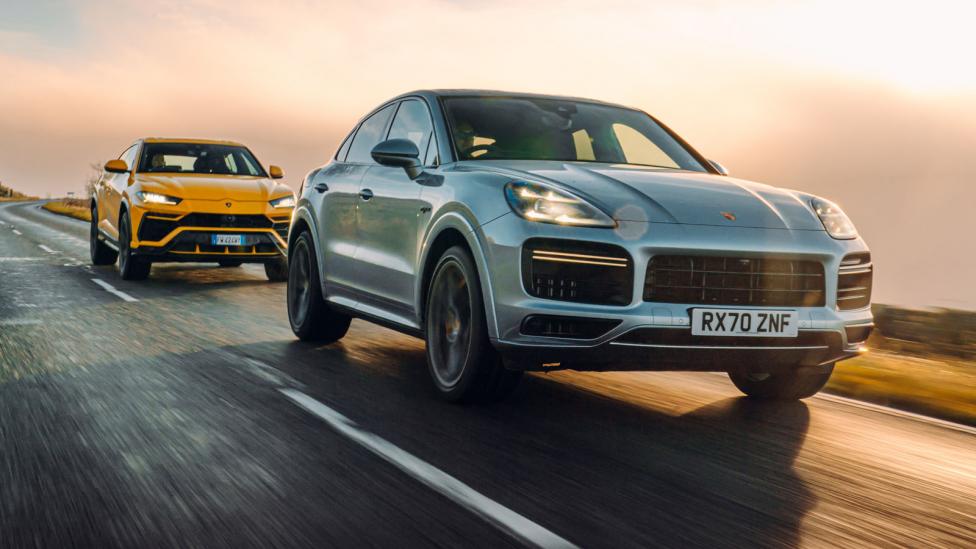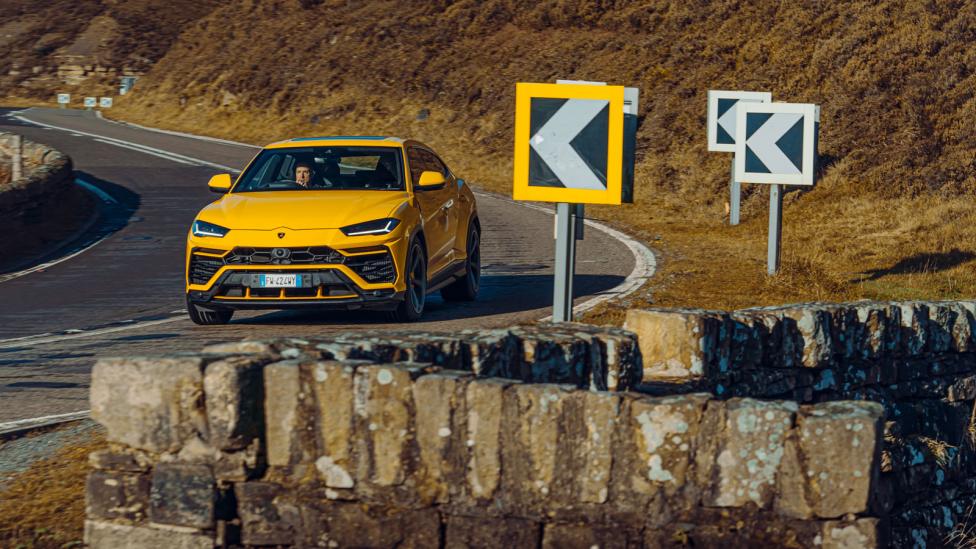Aston DBX vs Bentley Bentayga vs Lambo Urus vs Porsche Cayenne
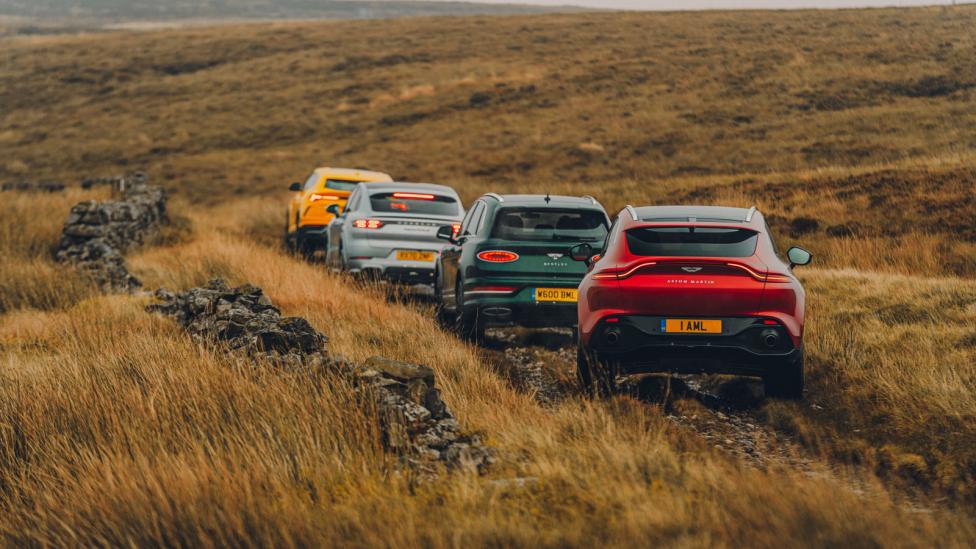
He’s got headphones in. And I’d spent all morning driving the Cayenne about in Sport mode. Mutually exclusive events that were about to cause a minor back road irritation. Unable to charge the Porsche’s battery last night, I’d used our morning charge (the other type of charge) around Winnats Pass and over the Snake Road to prepare our only hybrid for a friendly, unintimidating run along the pretty, popular-with-walkers, one-way-for-cars lane through Goyt Valley.
Eighty kilometres of charging had bought me six kilometres of charge. Is that good? Who knows? But I thought that this approach was not only conscientious, but also served as a useful reminder of what the Porsche Cayenne Turbo S E-Hybrid Coupe (and breathe...) is capable of that its internally combusted-only rivals aren’t.
However, this 13kph cyclist with his plugs in can’t hear this 2.5-tonne silent-running SUV a respectful distance behind him. He carries on, admiring the scenery. Tooting would be rude, swerving or getting closer about as acceptable as my other potential solution – pulling over and letting the rowdy Urus have a run at him.
So I do the one thing I didn’t want to: switch back to Sport mode and let the hydrocarbons combust. The V8 rumbles into life and whether via sound waves, olfactory assault or road vibration, the message gets through. He pulls over and shoots me a dirty look. Well, I tried.
I expect the look got dirtier. In this company a silver Porsche Cayenne is the gentlest way to part the waves. It’s not the metaphorical and visual bow wave that is a yellow Lamborghini Urus, that’s for sure. Just as well the Aston was at the back. Everyone loves an Aston, so hopefully it’ll minimise the wake we leave.
Words: Ollie Marriage Photography: Mark Riccioni
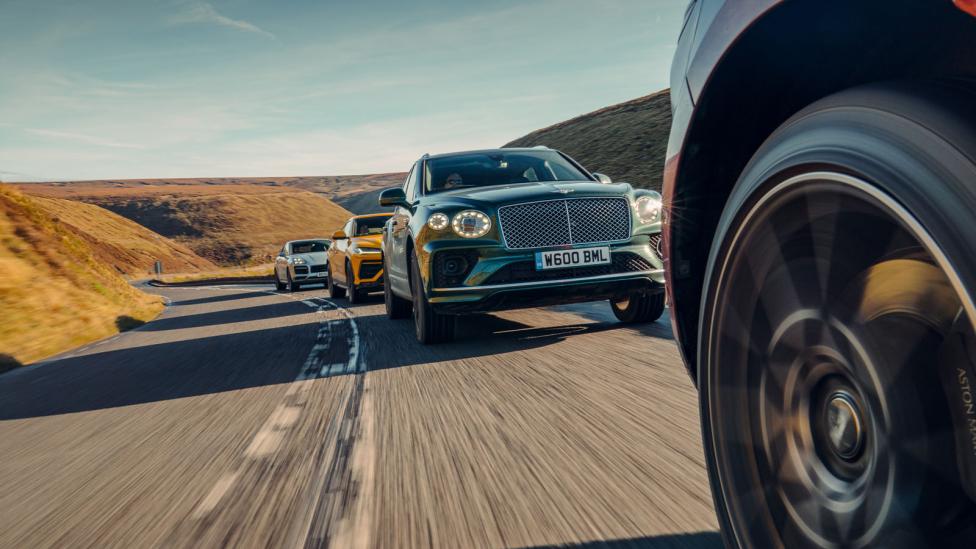
And this stuff matters. We could – and others do – evaluate these SUVs purely on their driving ability, but we all know the truth of it. These cars are brand ambassadors. Status is what matters here. I put the Porsche at the front as much because it’s the cheapest, most common and least obnoxious, as because of its electric running. It’s the most established, carries the least baggage, is the happiest in its own skin.
What to make of the others? It’s complicated. In many ways they’re not comparable. We wouldn’t compare a Huracán with a Continental GT, because they don’t do the same job. Well, guess what? Scale up to SUVs and they still don’t. Each is too caught up conveying its own brand image to deviate into being the best SUV it can be. They’re not designed to be good SUVs, but good representatives of the raging bull or winged B. Having said that, knowing what you do about each company, which aligns best with traditional SUV attributes?
Bentley, right? Comfort, refinement, weight and so on. So if we ask this simple question: ‘which is the best SUV here?’, the answer is right there in front of you. The Bentley is. It’s got the most interior space, the plushest ride, the quietest cabin, the most off-road ability. If that’s your only question, there’s your answer. Bentley even does it as a hybrid. Well it used to, but it wasn’t much good. However, given Bentley’s recent statement about having a plug-in version of every model by 2023 and going all-electric by 2030, you know one’ll be along shortly.
The others fall into place with equal logic. And yes, if this dictates the Urus to be the most flawed SUV, well, there you are. Now, what’s interesting is that although they come across differently and each successfully epitomises its brand values, three of them are built from the same basic kit. As VW Group products the Bentley, Porsche and Lambo are all based on the same MLB Evo platform and all use a broadly similar twin turbo 4.0-litre V8. You’d never guess. They sound different, act different.
The Aston also uses a 4.0-litre blown V8, but it’s sourced from Mercedes (which recently committed to taking a 20 per cent stake in Aston). The bonded aluminium platform underneath the DBX isn’t shared with anything else and the car itself feels very different to the others. They are very corporate products, with standardised materials, proven design, excellence engineered in. They reek of deep development budgets. The Aston? Well, let’s just say it comes across as more individual.
The Aston, with its little duck tail and confident stance, just looks... great
This is not a bad thing. The Bentayga and Urus feel slightly generic next to the Aston. Yes, there is carry over from the Vantage and DBS, but it feels like a bespoke creation, not a Touareg or Q8 with a thick veneer of sophistication applied. However, to lump them all in together for a little longer, the VW Group’s excellence means three are fabulously well made. The other, built in a brand new factory at St Athan in Wales, has a few niggles. It’s to be expected, but the electric windows refusing to raise and the occasional ping from the dashboard do give cause for concern.
I like the storage area under the transmission tunnel, but the shallow phone tray hits eject at every roundabout, and there’s no induction charging or USB slot down there, so you’ve still got to trail a cable around. And then we get to the infotainment. It’s Merc’s but a couple of generations old. No touchscreen and fairly primitive CarPlay integration. Even over the course of a week I didn’t stop finding the clickwheel and pad frustrating. The trouble is that the sort of people the Aston is aimed at will have bought their live-in nanny a Golf that does all this stuff, and probably has proper matrix LED lights, yet their new luxury purchase for taking the kids out on her day off, doesn’t.
You wouldn’t catch a Porsche playing second fiddle to a VW. In the Cayenne you find broad screens, fast processors, touch sensitive panels, massive functionality. Bentley isn’t far behind, with tactility firmly to the fore. A Lamborghini shouldn’t be straightforward, but this one nearly drops the ball. It’s mostly fathomable.
And probably more practical than it needs to be. I refer you to the point I made earlier about each car having to epitomise its own brand. Here’s an Urus that can actually handle four (ideally shortish) people and most of their trinkets. And so can the others. The surprise, in a way, is the Aston – in that it’s more spacious than you expect. Rear legroom is Bentley-rivalling and the boot isn’t far off either.

You don’t expect much of the DBX because of its pinched waist and svelte looks, plus the fact no other Aston is especially well packaged. The design is clever. It doesn’t look big, but actually only the Porsche is under five metres long. But more importantly, the Aston is properly handsome. Yes, the facelifted Bentayga isn’t as bad as it used to be (or perhaps time has sharpened its lumpen form), the Urus has so many edges and angles you wouldn’t be surprised if the wheels were square (come to think of it, that might explain a few things...) and the Porsche is a visual bar of soap. Especially as a coupe. But the Aston, with its little duck tail and confident stance, just looks... great.
Parked up among the regency architecture of Buxton the previous evening, it’s the one that had drawn all the attention – although a straw poll suggested this had more to do with this exact car having been piloted by Paddy on the TV show only a few days before. But people do admire it, it’s a great thirsty, dirty SUV that people compliment you on. And that’s not the case with any of the others.
No one wants to start the Lamborghini outside the hotel at 6.30 the next morning. Should have parked on a downward slope and just coasted quietly away. It’s a mouthy bugger first thing, trumpeting V8 easily penetrating the fog. Paddy drove an Urus on the TV show recently as well (he does love a fast SUV). If you haven’t seen the film of it against the Audi RS6, dig it out, if only to see how little the Urus rolls when being Stigged. It’s uncanny. Like the Bentley and Porsche it has a 48V roll control system that uses electric motors to apply torque to the active anti-roll bars. The system is very clever – in fact it’s arguably been the making of all these premium sports SUVs, allowing a tall car with a high centre of gravity to have astonishing body control.
The 641bhp Urus is the fastest car here and as the fog becomes mist and the sun tantalises on the way to Winnats Pass, it has a chance to prove itself. Left alone, the ride’s reasonably well cushioned (it doesn’t need stiff air springing because of the 48V system), but you don’t leave a Lamborghini alone, you drive it. In Sport mode it corners flat and fast, and the deep-chested engine, 100bhp up on the British pair, is a sledgehammer that hits hard everywhere – especially at the top end. But as speeds rise, so it becomes more tense, the Urus having to keep a very rigid grip of itself. The ride becomes a bit skittish – especially through corners – and it’s only if you catch a glance of the speedo that you’re aware of how fast you’re moving, the momentum you’ve built. Because you’re not getting the signals you expect from the suspension and overly light steering. The brakes certainly do the job, which is not something that can be said of the Bentley. But then you never find yourself wanting to drive the more stately Bentley fast. Overall, it’s mostly got the manners to perform in town and over long distances, but on twisting roads it rarely settles, driving like it’s got an itchy collar.
We went off-road too. Much further than we’d intended because all of them coped so well
We’ve descended into subterranea – at the bottom of Winnats Pass the fog is a grey gloop. But just three kilometres away at Mam Tor it’s a different story, one where low orange sunlight pings off bodywork. I switch to the Porsche. It’s immediately more natural in its movements, the steering is better weighted and the driving experience less fierce and aggressive. This more relaxed approach actually makes the Porsche better through corners. There’s enough movement and communication to let you know how hard it’s working. It’s less overtly aggressive, and more deeply satisfying.
And not slow. A 14.1kWh battery feeds a single 136bhp electric motor mounted between engine and eight-speed auto gearbox. With 671bhp, it’s the most potent car here. And also the heaviest. This is a dense, complex piece of engineering, and it works very intelligently indeed, deciding how and when to use the engine, e-motor and gearbox seamlessly. The only weak link is the brakes – not outright power, but inconsistent feel under your foot when the system is deciding between electric regen and disc stopping.
The Aston pushes the Porsche hard – and asks interesting questions about how fast a super-SUV actually needs to be. Not once while driving it did I think it needed more performance, despite being a second slower to 100kph. Not important. It sounds good, goes hard enough and – best of all – feels clean and natural to drive with clear lines of communication. Everything is in the right proportion: the body roll, the steering weight and feel, the operation of the pedals - it’s an easy, content, well-mannered car to just get in and drive before you’ve even found the little mode controller on the console (we’d have liked to see it on the steering wheel as in the Vantage).
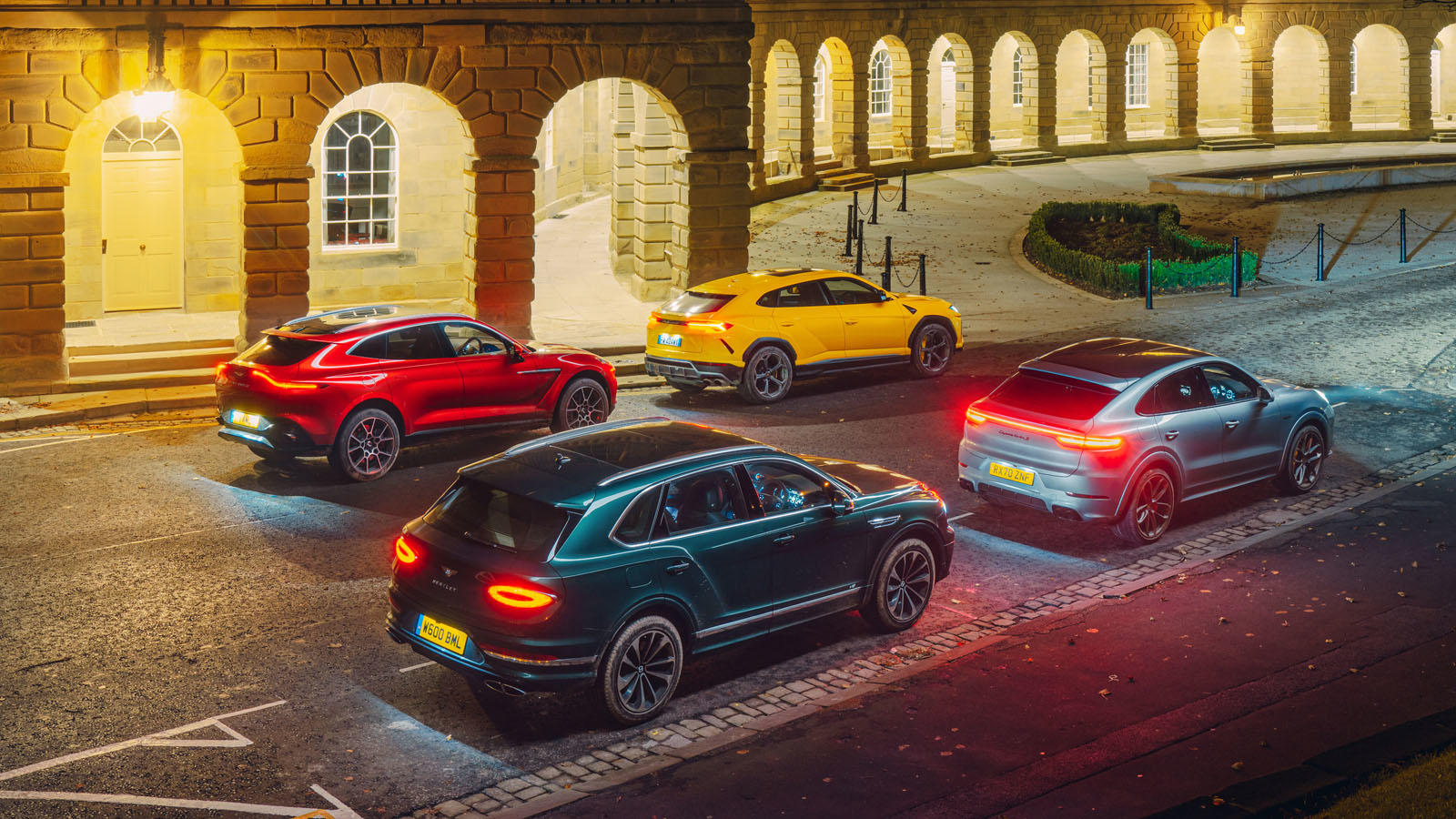
There is a but. It does less to shelter you from the buffeting that the road doles out. Whether it’s vibrations, noise, background rumbles, there’s just a little too much commotion going on. The ride itself is mostly pliant, maybe a little firm, but you’re less well distanced from the oily bits. You feel tyre tremors through the seat and jumping into the Bentley after it is a marked change. Silence. Refinement. A car that asks for no compromise. Provided you don’t try and jet along. At the end of a tight road, the Bentayga puts its hands on its knees and wheezes. The big lad’s not keen. Long throttle, soft brakes, a bit dozy. Everywhere else: a picture of refinement and ease. You glide, you ooze – although as with all its rivals, if one of these big, heavy wheels hits an expansion joint, the air suspension does kick noticeably.
We went off-road too. Much further than we’d intended because all of them coped so well. Height adjustable suspension, well calibrated traction and 4WD make that not just possible, but easy. Bentley was the most at home, Urus the least. Tell me that surprises you. Those two cars bracket this class. The Aston Martin tries to deliver elements of both, but really the car it most feels like is the Porsche – it has the same focus on driving cleanly, smoothly and communicatively. Sport-ish, without the aggression. Sorting them into an order is nigh-on pointless for reasons already laid out. Got a brand affiliation? Have that one. As already discussed the Bentley does the job of a load-hauling, family-packed SUV better than the others.
But would you be seen in one? Not just the visuals, but the baggage that goes with owning a car that returned 15.1l/100km with us (the DBX and Urus were worse still). The Porsche is here to highlight the urgency of hybrid for these cars. Does it work? What does 13.7l/100km tell you? Not really, its 122g/km of CO2 (against over 300 for the others) merely assuages your guilt at dinner parties.
For now the DBX gets a pass due to its looks and image. It’ll need more soon. And better cabin tech and equipment levels. More insulation, too. Fundamentally it’s a good car, one that I’d argue actually performs better in its sector than the Vantage or DB11 do in theirs. It’s an individual and interesting SUV that just lacks the last bit of polish. Not the first time we’ve said that about an Aston, and probably not the last.
